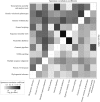Bioinformatic training needs at a health sciences campus
- PMID: 28614396
- PMCID: PMC5470718
- DOI: 10.1371/journal.pone.0179581
Bioinformatic training needs at a health sciences campus
Abstract
Background: Health sciences research is increasingly focusing on big data applications, such as genomic technologies and precision medicine, to address key issues in human health. These approaches rely on biological data repositories and bioinformatic analyses, both of which are growing rapidly in size and scope. Libraries play a key role in supporting researchers in navigating these and other information resources.
Methods: With the goal of supporting bioinformatics research in the health sciences, the University of Arizona Health Sciences Library established a Bioinformation program. To shape the support provided by the library, I developed and administered a needs assessment survey to the University of Arizona Health Sciences campus in Tucson, Arizona. The survey was designed to identify the training topics of interest to health sciences researchers and the preferred modes of training.
Results: Survey respondents expressed an interest in a broad array of potential training topics, including "traditional" information seeking as well as interest in analytical training. Of particular interest were training in transcriptomic tools and the use of databases linking genotypes and phenotypes. Staff were most interested in bioinformatics training topics, while faculty were the least interested. Hands-on workshops were significantly preferred over any other mode of training. The University of Arizona Health Sciences Library is meeting those needs through internal programming and external partnerships.
Conclusion: The results of the survey demonstrate a keen interest in a variety of bioinformatic resources; the challenge to the library is how to address those training needs. The mode of support depends largely on library staff expertise in the numerous subject-specific databases and tools. Librarian-led bioinformatic training sessions provide opportunities for engagement with researchers at multiple points of the research life cycle. When training needs exceed library capacity, partnering with intramural and extramural units will be crucial in library support of health sciences bioinformatic research.
Conflict of interest statement
Figures




References
-
- Van Horn JD. Big data biomedicine offers big higher education opportunities. Proc Natl Acad Sci USA. 2016;113:6322–6324. doi: 10.1073/pnas.1607582113 - DOI - PMC - PubMed
-
- Meyers FJ, Pomeroy C. Creating the future biomedical research workforce. Sci Transl Med. 2011;3:102fs5 doi: 10.1126/scitranslmed.3003209 - DOI - PubMed
-
- Sinha G. A career in cancer research? Computational skills wanted. Science. 2016;352:250–254. doi: 10.1126/science.opms.r1600163 - DOI
-
- Human Genomics Strategy Group. Building on our inheritance: Genomic technology in healthcare. London: Department of Health. 2012. Available: https://www.gov.uk/government/publications/genomic-technology-in-healthc....
-
- Margolis R, Derr L, Dunn M, Huerta M, Larkin J, Sheehan J, et al. The National Institutes of Health’s Big Data to Knowledge (BD2K) initiative: capitalizing on biomedical big data. J Am Med Inform Assoc. 2014;21:957–958. doi: 10.1136/amiajnl-2014-002974 - DOI - PMC - PubMed
MeSH terms
LinkOut - more resources
Full Text Sources
Other Literature Sources
Medical

